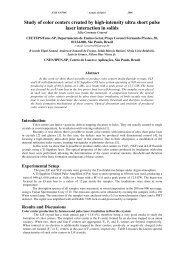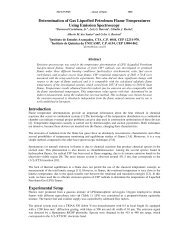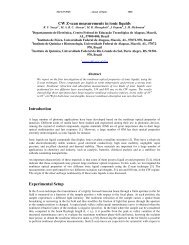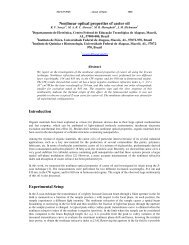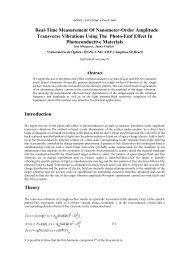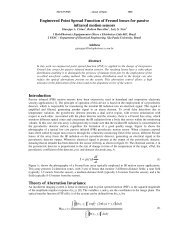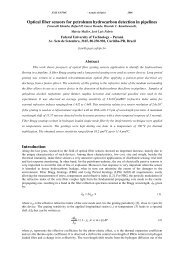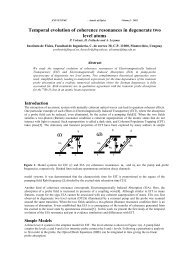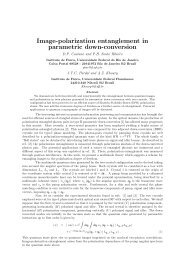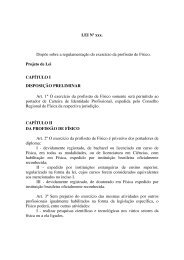Fresnel lens array with spatial filtering for passive infrared motion ...
Fresnel lens array with spatial filtering for passive infrared motion ...
Fresnel lens array with spatial filtering for passive infrared motion ...
You also want an ePaper? Increase the reach of your titles
YUMPU automatically turns print PDFs into web optimized ePapers that Google loves.
XXIX ENFMC - Annals of Optics 2006<br />
<strong>Fresnel</strong> <strong>lens</strong> <strong>array</strong> <strong>with</strong> <strong>spatial</strong> <strong>filtering</strong> <strong>for</strong> <strong>passive</strong> <strong>infrared</strong><br />
<strong>motion</strong> sensor applications<br />
Giuseppe A. Cirino 1 ,Robson Barcellos 1 , Luiz G. Neto 2 , Ronaldo D. Mansano 3 , Allan Bereczki 4 , Spero P. Morato 4<br />
1 HoloPhotonics Equipamentos Óticos e Eletrônicos Ltda-ME, Brazil<br />
2 EESC – Department of Electrical Engineering, São Paulo University, Brazil<br />
3 LSI-PSI-EPUSP –Polytechnic School, São Paulo University, Brazil<br />
4 LaserTools Tecnologia Ltda, Brazil<br />
Address<br />
giuseppe@holophotonics.com.br<br />
Abstract<br />
In this work a <strong>Fresnel</strong> <strong>lens</strong> <strong>array</strong> <strong>for</strong> Passive InfraRed (PIR) <strong>motion</strong> sensors was designed,<br />
fabricated and tested. The resulting <strong>spatial</strong> <strong>filtering</strong> <strong>lens</strong> <strong>array</strong> presents the capability of<br />
distinguishing the presence of humans from small pets. Such <strong>array</strong> - designed to operate in the<br />
visible range of the spectrum - was manufactured on a Diamond-Like Carbon (DLC) thin film,<br />
using well-known microfabrication process steps. The optical testing was per<strong>for</strong>med <strong>with</strong> an<br />
incoherent white light source. The fabricated <strong>lens</strong> was used to image an intensity input object onto<br />
a CCD <strong>array</strong> camera. The obtained results demonstrate that the optical power detected is<br />
attenuated <strong>for</strong> targets <strong>with</strong> inherently horizontal mass distribution (e.g. pets) while the optical<br />
power is enhanced <strong>for</strong> targets <strong>with</strong> vertical mass distribution (e.g. humans).<br />
Introduction<br />
PIR <strong>motion</strong> sensors has been extensively used in domestic and corporative electronic security applications. Its<br />
principle of operation is based on pyroelectric detectors – a PZT ceramic-based device which is responsible <strong>for</strong><br />
transducing the incident IR radiation into electric signal. Associated <strong>with</strong> the photo detector and conditioning<br />
circuitry [1], there is a multi zonal <strong>Fresnel</strong> <strong>lens</strong> <strong>array</strong>, which monitors different <strong>spatial</strong> zones and collects the IR<br />
radiation from a body that moves inside the monitoring volume. The <strong>lens</strong>es are designed to concentrate as much<br />
IR radiation as possible onto the detector´s surface. The electrical current in the in the pyroelectric detector is<br />
proportional to the rate of change in time of the temperature of the target. The electrical wave<strong>for</strong>m at the<br />
pyroelectric detector output depends on the distance between the detector and the target mass, on the amount of<br />
mass present in the target, and on the speed of the target <strong>with</strong> respect to the sensor. The sensor operates in the<br />
range of 8-14 micrometers wavelength. Whenever electrical signal is present at the output of the pyroelectric<br />
detector, meaning that an intruder has been detected, the sensor will trip. Figure 1 shows the photography of the<br />
phase distribution, mapped in grayscale, of a <strong>Fresnel</strong> <strong>lens</strong> typically employed in IR <strong>motion</strong> sensor applications.<br />
Figure 1a shows an image of the phase distribution of a conventional <strong>lens</strong> <strong>array</strong>, and figure 1b shows the phase<br />
distribution of the proposed <strong>Fresnel</strong> <strong>lens</strong> <strong>array</strong> <strong>with</strong> <strong>spatial</strong> <strong>filtering</strong>.<br />
(a)<br />
(b)<br />
Figure 1: Photography of a multi-zonal, segmented <strong>Fresnel</strong> <strong>lens</strong> typically used in PIR<br />
sensors. (a) grayscale image of the phase distribution of a conventional segmented <strong>Fresnel</strong><br />
<strong>lens</strong> <strong>array</strong>, (b) grayscale image of the phase distribution of the proposed <strong>Fresnel</strong> <strong>lens</strong> <strong>array</strong><br />
<strong>with</strong> <strong>spatial</strong> <strong>filtering</strong>.<br />
Several companies have been employing various techniques in order to give the sensor the ability of distinguish<br />
human targets from pet targets. They are based on the use of microcontrollers, to execute a digital postprocessing<br />
of the electric signal generated by the pyroelectric transducer, i.e., the signal is collected and then<br />
processed (filtered) [2]. A low-cost solution, however, can be obtained by employing optical <strong>filtering</strong>. The phase<br />
distribution of the <strong>Fresnel</strong> <strong>lens</strong> <strong>array</strong> of the sensor can be modified in order to accomplish the distinction between
XXIX ENFMC - Annals of Optics 2006<br />
the presence of humans and pets through optical processing. To solve the pet immunity problem in PIR <strong>motion</strong><br />
sensors, an approach that consists of a hybrid optical pre-processing/digital post-processing, also called<br />
wavefront coding [3-5], can be applied. Authors have reported the successfull employment of wavefront coding<br />
to correct the aberrations present in incoherent image systems [6,7], making them invariant to misfocus <strong>with</strong>in a<br />
predefined range of image plane distances as well as correcting the transversal chromatic aberration [8]. Because<br />
of the aberration invariance, it is possible to use low-cost and low-precision optics to produce a system <strong>with</strong> a<br />
per<strong>for</strong>mance similar to those using high-cost and high precision optics, or near diffraction-limited optical<br />
systems. In this paper we verify the application of the cubic phase distribution to improve the immunity of PIR<br />
sensors to false alarms generated by domestic pets. More details about the design and application of wavefront<br />
coding can be found on a previous work [9,10].<br />
Application of the proposed <strong>Fresnel</strong> <strong>lens</strong> <strong>array</strong> on PIR <strong>motion</strong> sensors<br />
Regular <strong>Fresnel</strong> <strong>lens</strong>es used in PIR <strong>motion</strong> sensors do not distinguish the presence of humans from pets. In order<br />
to accomplish this distinction using a low-cost solution, the phase distribution of the proposed <strong>lens</strong> is<br />
superimposed on the regular quadratic phase distribution <strong>lens</strong> (figure 1b). In our application, the new <strong>lens</strong>es are<br />
used as a <strong>spatial</strong> filter rather than as an imaging system. The filter was applied in one-dimension (in the vertical<br />
direction), and might be located at the exit pupil of the optical system (just behind the conventional quadratic<br />
distribution <strong>lens</strong> ). Its phase function has the <strong>for</strong>m shown in equation 1, where P v is the generalized exit pupil<br />
function, located in the (x p ,y p ) exit plane [3].<br />
3<br />
[ j20πy<br />
]<br />
PV<br />
( x<br />
p<br />
, y<br />
p<br />
) = exp<br />
p<br />
(1)<br />
Figure 2 shows the results of a numerical simulation. Figure 2a shows the intensity distribution of an input<br />
image containing typical, scale-respect, a human and a small pet silhouettes. Figure 2b shows the respective<br />
intensity distribution of the output image obtained from the input distribution of figure 2a, after processed by the<br />
resulting <strong>lens</strong> (figure 1b). One can note from figure 2b that the image of the human body has higher brightness<br />
when compared <strong>with</strong> the image of the small pet. There<strong>for</strong>e, the <strong>lens</strong> of figure 1b makes possible to distinguish<br />
the presence of humans from pets, based only on optical <strong>filtering</strong>.<br />
(a)<br />
(b)<br />
Figure 2: Numerical results. (a) Intensity distribution of an input image containing typical,<br />
scale-respect, human and a small pet silhouettes; (b) intensity distribution of the respective<br />
image obtained from the input distribution of figure 2a, after processed by the resulting<br />
cubic-phase distribution of the <strong>lens</strong> (figure 1b).<br />
Manufacturing process of proposed <strong>Fresnel</strong> <strong>lens</strong>es<br />
In order to show how the <strong>lens</strong> can be employed in the distinction of human targets from pet targets, we designed<br />
and manufactured a <strong>lens</strong> set on DLC thin film by microfabrication process techniques [11, 12], such as plasmaassisted<br />
deposition, microlithography and plasma etching. Although the sensor operates at the 8-14 micrometers<br />
wavelength range, we fabricated a diffractive <strong>Fresnel</strong> <strong>lens</strong> which operates in the visible portion of the spectrum,<br />
<strong>with</strong> a central wavelength of 500 nm. This is a suitable way to show that the principle works, being directly<br />
applied in the desired wavelength range (mid infra-red). For comparative purposes, besides each cubic-phase<br />
distribution <strong>Fresnel</strong> <strong>lens</strong>, we fabricated also a conventional <strong>Fresnel</strong> <strong>lens</strong>. Both <strong>lens</strong>es were submitted at the same<br />
process steps during the whole fabrication process. The continuous phase distribution shown on figure 1b might<br />
be implemented through a micro-relief on the 1.5 mm-thick DLC layer, using the following relation (equation 2),<br />
where th(x p ,, y p ) is the thickness variation <strong>with</strong>in the transparent carbon film, λ is the operating wavelength, n DLC<br />
is the refractive index of the DLC layer (measured at wavelength λ) and φ(x p ,y p ) is the phase distribution<br />
in<strong>for</strong>mation [0 ≤ φ(xp,yp) ≤ 2π] [13].
XXIX ENFMC - Annals of Optics 2006<br />
λ<br />
th ( xP<br />
, yP<br />
) = φ ,<br />
(2)<br />
2π<br />
( ) ( x ) P<br />
yP<br />
n −1<br />
DLC<br />
Based on a previous work [10, 14] the process which was adopted <strong>for</strong> deposition of the films, has a deposition<br />
rate of approximately 16 nm/min. Varying the processing time up to 90 minutes yielded films <strong>with</strong> different<br />
thicknesses up to 1500 nm. The deposition rate proved to be constant in time [15]. The refractive index of the<br />
film, n DLC , as deposited onto a silicon wafer and measured by ellipsometry technique, is 1.60 at the 633 nm<br />
wavelength. A DLC film of 2 µm thick absorbs approximately 6% of the incoming light (400 < λ < 700 nm), as<br />
measured by the UV-Vis-NIR spectrometric technique [16,17]. In order to fabricate diffractive structures <strong>with</strong> 8<br />
phase levels, it is necessary to per<strong>for</strong>m three lithographic steps followed by plasma etching sequences: the first<br />
one which removes 104 nm (π/4 phase modulation), the second one which removes 208 nm (2π/4phase<br />
modulation) and the third one which removes 416 nm (4π/4 phase modulation). In this way, the maximum<br />
thickness of removed film is 728 nm (7π/4 phase modulation). A photography of a wafer <strong>with</strong> the fabricated<br />
diffractive <strong>lens</strong>es is shown in figure 3a. More details about the micromachining process steps <strong>for</strong> <strong>lens</strong> fabrication<br />
can be found on previous works [10,14].<br />
Optical results<br />
Figure 3b shows the experimental set up employed to per<strong>for</strong>m the comparative tests. The object, located in the<br />
back focal plane of the <strong>lens</strong>, is illuminated by a diffused incoherent white light source. The <strong>lens</strong> produces the<br />
image the object directly in the plane of the CCD camera.<br />
(a)<br />
(b)<br />
Figure 3: (a) Photography of a 3-inch diameter glass wafer <strong>with</strong> both the proposed (cubic<br />
phase) and conventional (quadratic phase) <strong>lens</strong>es; (b) experimental set up employed to store<br />
the images produced by the fabricated <strong>Fresnel</strong> <strong>lens</strong>es. The object plane is illuminated by a<br />
diffused incoherent white light source and the <strong>lens</strong> images the object directly in the CCD<br />
plane of the camera.<br />
Figure 4 shows the resulting images <strong>for</strong>med by the fabricated <strong>Fresnel</strong> <strong>lens</strong>es. Figure 4a and 4b show the resulting<br />
images from the conventional <strong>lens</strong> (quadratic phase profile) and the proposed <strong>lens</strong> (cubic phase profile),<br />
respectively. One can see that cubic phase profile spreads the light as predicted by the simulated results. The<br />
optical power generated by pet targets is attenuated (to a value of about 50% of the maximum value), as<br />
compared <strong>with</strong> human targets. There<strong>for</strong>e we showed that wavefront coding approach can be used to allow some<br />
blurring of the PSF of the optical system in such a way that it turns possible the discrimination between humans<br />
and pets <strong>for</strong> <strong>passive</strong> infra-red <strong>motion</strong> sensor applications.<br />
Conclusions<br />
In this work we described the wavefront coding method applied to <strong>passive</strong> <strong>infrared</strong> <strong>motion</strong> sensors. The new<br />
proposed <strong>lens</strong> has the ability to distinguish the presence of humans from pets. The <strong>lens</strong>es are designed<br />
considering a cubic phase distribution placed in the exit pupil plane of the sensor. We verified the behavior of<br />
the cubic phase mask in one-dimensional systems, testing this distribution in the vertical as well as horizontal<br />
directions. We simulated several qualitative human bodies in different conditions, and small pets. Through the<br />
fabrication of conventional quadratic phase profile and proposed cubic phase profile <strong>lens</strong>es, we demonstrate that<br />
the proposed system is able to enhance the in<strong>for</strong>mation of the vertical features, turning possible, in this way, the<br />
distinction of the presence of humans from pets. The novelty of this work is the fact that the so-called pet<br />
immunity function was implemented in a purely optical filter. As a result, this approach allows one to reduce<br />
some hardware parts as well as decrease the software complexity once the in<strong>for</strong>mation about the intruder<br />
transduced by the pyroelectric sensor has already been optically processed.
XXIX ENFMC - Annals of Optics 2006<br />
(a)<br />
(b)<br />
Figure 4: Resulting intensity images generated from the <strong>Fresnel</strong> <strong>lens</strong>es in the visible range<br />
of spectrum. (a) resulting image from the conventional (quadratic phase profile) <strong>lens</strong>; (b)<br />
resulting image from the proposed <strong>lens</strong> (cubic phase profile). One can note the<br />
enhancement of the human body intensity distribution<br />
Acknowledgements<br />
The authors would like thanks to FAPESP <strong>for</strong> financial support.<br />
References<br />
[1] US patents: 4,052,616 (1977), 4,321,594 (1982), 4,535,240 (1985).<br />
[2] US patents: 5,473,311 (1995), 5,670,943 (1997), 5,870,022 (1999), 6,188,318 B1 (2001).<br />
[3] Edward R. Dowski, Jr., and W. Thomas Cathey “Extended depth of field through wave-front coding”<br />
Applied Optics, 34 (11), 1859-1866 (1995).<br />
[4] Dowski, E. R. Jr. and Johnson, G. "Marrying optics & electronics: Aspheric optical components improve<br />
depth of field <strong>for</strong> imaging systems", Optical Engineering Magazine, 2 (1), 42-43 (2002).<br />
[5] US patents: 5.748.371 (1998), 6.069.738 (2000).<br />
[6] Dowski, E. R. Jr.; Cathey, W.T.; van der Gracht, J. “Aberration Invariant Optical/Digital Incoherent optical<br />
Systems”, Publication of the Imaging System Laboratory Department of Electrical Engineering, University<br />
of Colorado, Boulder, available (07/18/02) at: http://www.colorado.edu/isl/papers/aberrinv.pdf<br />
[7] Cathey, W. T.; Dowski, E. R.; and Alan R. FitzGerrell, A. R. "Optical/Digital Aberration Control in<br />
Incoherent Optical Systems" Publication of the Imaging System Laboratory, Department of Electrical<br />
Engineering, University of Colorado, Boulder, available (07/18/02) at:<br />
http://www.colorado.edu/isl/papers/aberration/paper.html<br />
[8] Wach, H.B., Cathey, W. T.and Dowski, E. R “Control of Chromatic Focal Shift Through Wavefront<br />
Coding” Publication of the Imaging System Laboratory Department of Electrical Engineering, University of<br />
Colorado, Boulder, available (07/18/02) at: http://www.colorado.edu/isl/papers/chromaberr.pdf<br />
[9] Cirino, G.A.; Neto, L.G. “Design of cubic distribution <strong>lens</strong>es <strong>for</strong> <strong>passive</strong> <strong>infrared</strong> <strong>motion</strong> sensors”,<br />
Thermosense XXV, Orlando, editors: K.E. Cramer & X.P. Maldague, Proceedings of the SPIE vol. 5073,<br />
pp.476-484, SPIE, Orlando-FL (2003).<br />
[10] Cirino, G.A.; Neto, L.G. “Optical implementation of cubic-phase distribution <strong>lens</strong>es <strong>for</strong> <strong>passive</strong> infra-red<br />
<strong>motion</strong> sensors”, Thermosense XXVI, Orlando, editors: Burleigh, D.B., Cramer, K.E. & Peacock, G.R.,<br />
Proceedings of the SPIE vol. 5405, pp.189-198, SPIE, Orlando-FL (2004).<br />
[11] Campbell, S.A., The Science and Engineering of Microelectronic Fabrication, Ox<strong>for</strong>d University Press:<br />
Ox<strong>for</strong>d and New York, pp. 252-275, 1996.<br />
[12] "Amorhous Hydrogened Carbon Film", International Application - Patent Cooperation Treaty, nr. PCT/BR<br />
02/00067 (2002).<br />
[13] O´Shea, D.C., Suleski, T.J., Kathman, A.D. & Prather, D.W., Diffractive Optics: Design, Fabrication and<br />
Test, SPIE Press: Washington, pp. 115-121, 2004.<br />
[14] L.G. Neto, P.S.P. Cardona, G.A. Cirino, R.D. Mansano, P. Verdonck; “Design, fabrication, and<br />
characterization of a full complex-amplitude modulation diffractive optical element”; J. Microlithography,<br />
Microfabrication and Microsystems, 2 (2), pp. 96-104, (2003).<br />
[15] R. D. Mansano, M. Massi, L. S. Zambon, P. Verdonck, P. M. Nogueira, H. S. Maciel, and C. Otani,<br />
‘‘Effects of the methane content on the characteristics of diamond-like carbon films produced by sputtering’’<br />
Thin Solid Films 373, pp. 243–246 (2000).<br />
[16] J.C. Manifacier, J. Gasiot, J.P.Fillard, “A simple method <strong>for</strong> the determination of optical constants n, k and<br />
the thickness of a weakly absorbing thin film”, J. of Physics E (9), pp.1002-1004 (1975).<br />
[17] L.D. Caro, M.C. Ferrara, “Simple method <strong>for</strong> the determination of optical parameters of inhomogeneous<br />
thin films”, Thin Solid Films 342, pp.153- 159 (1999).



